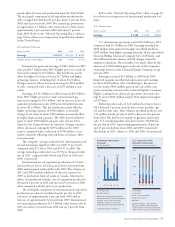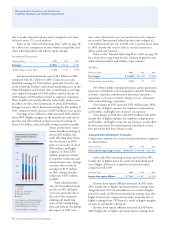Chevron 2011 Annual Report Download - page 27
Download and view the complete annual report
Please find page 27 of the 2011 Chevron annual report below. You can navigate through the pages in the report by either clicking on the pages listed below, or by using the keyword search tool below to find specific information within the annual report.Chevron Corporation 2011 Annual Report 25
Pension and OPEB expense is reported on the Con-
solidated Statement of Income as “Operating expenses” or
“Selling, general and administrative expenses” and applies to
all business segments. e year-end 2011 and 2010 funded
status, measured as the dierence between plan assets and
obligations, of each of the company’s pension and OPEB
plans is recognized on the Consolidated Balance Sheet. e
dierences related to overfunded pension plans are reported
as a long-term asset in “Deferred charges and other assets.”
e dierences associated with underfunded or unfunded
pension and OPEB plans are reported as “Accrued liabilities”
or “Reserves for employee benet plans.” Amounts yet to be
recognized as components of pension or OPEB expense are
reported in “Accumulated other comprehensive loss.”
To estimate the long-term rate of return on pension
assets, the company uses a process that incorporates actual
historical asset-class returns and an assessment of expected
future performance and takes into consideration external
actuarial advice and asset-class factors. Asset allocations
are periodically updated using pension plan asset/liability
studies, and the determination of the company’s estimates
of long-term rates of return are consistent with these stud-
ies. e expected long-term rate of return on U.S. pension
plan assets, which account for 70 percent of the company’s
pension plan assets, has remained at 7.8 percent since 2002.
For the 10 years ending December 31, 2011, actual asset
returns averaged 5.0 percent for this plan. e actual return
for 2011 was slightly negative and was associated with the
broad decline in the nancial markets in the second half of
the year. Additionally, with the exception of two other years
within this 10 year period, actual asset returns for this plan
equaled or exceeded 7.8 percent.
e year-end market-related value of assets of the major
U.S. pension plan used in the determination of pension
expense was based on the market value in the preceding three
months, as opposed to the maximum allowable period of ve
years under U.S. accounting rules. Management considers
the three-month period long enough to minimize the eects
of distortions from day-to-day market volatility and still be
contemporaneous to the end of the year. For other plans,
market value of assets as of year-end is used in calculating
thepension expense.
e discount rate assumptions used to determine U.S.
and international pension and postretirement benet plan
obligations and expense reect the prevailing rates available on
high-quality xed-income debt instruments. At December 31,
2011, the company selected a 3.8 percent discount rate for the
major U.S. pension plan and 4.0 percent for its OPEB plan.
ese rates were selected based on a cash ow analysis that
matched estimated future benet payments to the Citigroup
Pension Discount Yield Curve as of year-end 2011. e dis-
count rates at the end of 2010 and 2009 were 4.8 percent and
5.3 percent, respectively, for the major U.S. pension plan, and
5.0 percent and 5.8 percent, respectively, for the company’s
U.S. OPEB plan.
An increase in the expected long-term return on plan
assets or the discount rate would reduce pension plan
expense, and vice versa. Total pension expense for 2011 was
$1.2 billion. As an indication of the sensitivity of pension
expense to the long-term rate of return assumption, a 1 per-
cent increase in the expected rate of return on assets of the
company’s primary U.S. pension plan would have reduced
total pension plan expense for 2011 by approximately
$75million. A 1 percent increase in the discount rate for
this same plan, which accounted for about 63 percent of the
companywide pension obligation, would have reduced total
pension plan expense for 2011 by approximately $145 million.
An increase in the discount rate would decrease the
pension obligation, thus changing the funded status of
a plan reported on the Consolidated Balance Sheet. e
aggregate funded status recognized on the Consolidated
Balance Sheet at December 31, 2011, was a net liability of
approximately $5.4 billion. As an indication of the sensitivity
of pension liabilities to the discount rate assumption, a 0.25
per cent increase in the discount rate applied to the com-
pany’s primary U.S. pension plan would have reduced the
plan obligation by approximately $375 million, which would
have decreased the plan’s underfunded status from approxi-
mately $2.5 billion to $2.1 billion. Other plans would be
less underfunded as discount rates increase. e actual rates
of return on plan assets and discount rates may vary signi-
cantly from estimates because of unanticipated changes in
the world’s nancial markets.
In 2011, the company’s pension plan contributions were
$1.5 billion (including $1.2 billion to the U.S. plans). In
2012, the company estimates contributions will be approxi-
mately $900 million. Actual contribution amounts are
dependent upon investment results, changes in pension obli-
gations, regulatory requirements and other economic factors.
Additional funding may be required if investment returns are
insucient to oset increases in plan obligations.
For the company’s OPEB plans, expense for 2011 was
$220million, and the total liability, which reected the
unfunded status of the plans at the end of 2011, was $3.8 billion.
As an indication of discount rate sensitivity to the deter-
mination of OPEB expense in 2011, a 1 percent increase in
the discount rate for the company’s primary U.S. OPEB plan,
which accounted for about 76 percent of the companywide
OPEB expense, would have decreased OPEB expense by
approximately $10 million. A 0.25 percent increase in the
discount rate for the same plan, which accounted for about
81 percent of the companywide OPEB liabilities, would have
decreased total OPEB liabilities at the end of 2011 by approx-
imately $75 million.
For the main U.S. postretirement medical plan, the
annual increase to company contributions is limited to 4 per-
cent per year. For active employees and retirees under age 65
whose claims experiences are combined for rating purposes,
the assumed health care cost-trend rates start with 8 percent
in 2012 and gradually drop to 5 percent for 2023 and beyond.
As an indication of the health care cost-trend rate sensitivity
to the determination of OPEB expense in 2011, a 1 percent
increase in the rates for the main U.S. OPEB plan, which
accounted for 81 percent of the companywide OPEB liabili-
ties, would have increased OPEB expense by $8 million.
























